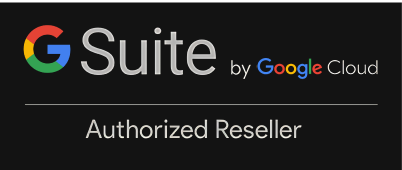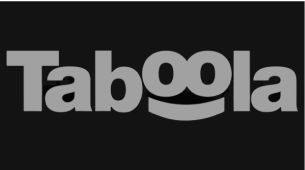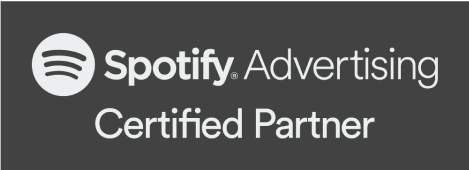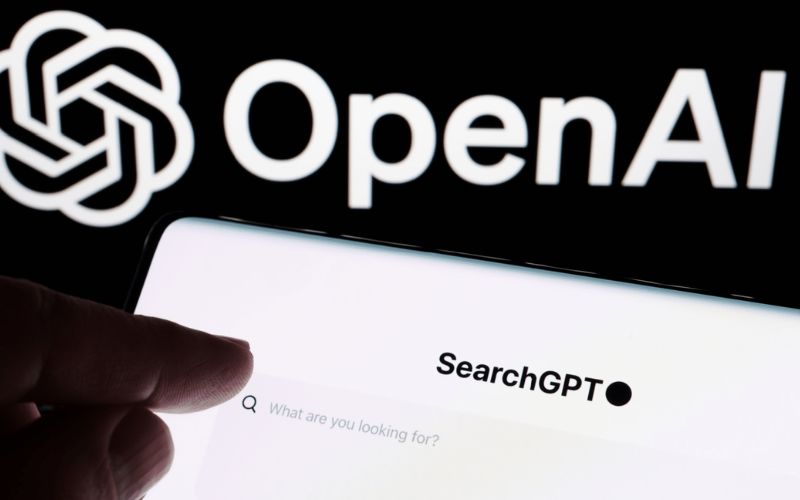
Last 25th July, OpenAI announced the SearchGPT search engine, a new AI search prototype that shifts the paradigm from keyword-based search to conversational search. This innovative model aims to offer a more intuitive and contextually aware search experience.
But as SearchGPT steps onto the stage, intriguing questions linger in the air. Can SearchGPT truly outshine other search engines? Will it truly respect the integrity of journalism and publishers? And most importantly, can it stay away from the mistakes that other AI attempts have made?
Let’s discover if SearchGPT is the next big thing or merely a fleeting trend. Learn about SearchGPT's features and potential, and how they can be optimised for brand visibility. Explore how this new tool could be used for enhanced engagement and growth in the digital landscape.
What’s Inside:
- SearchGPT Search Engine Overview
- Key Features of the SearchGPT Search Engine
- Comparing SearchGPT with Other AI-Search Platforms
- Enhancing eCommerce and Business Growth with SearchGPT
- Optimising Your Visibility with SearchGPT Search Engine
- Be Ready for the Future of Search with SearchGPT!
SearchGPT Search Engine Overview
What is SearchGPT Search Engine?
SearchGPT search engine is an advanced platform that combines cutting-edge technologies like natural language processing (NLP), machine learning algorithms, and large datasets to deliver precise and contextually appropriate search results. It moves beyond simple keyword matching, aiming to understand the context of user queries to generate human-like responses rather than just a list of links.
How Does SearchGPT Search Engine Work?
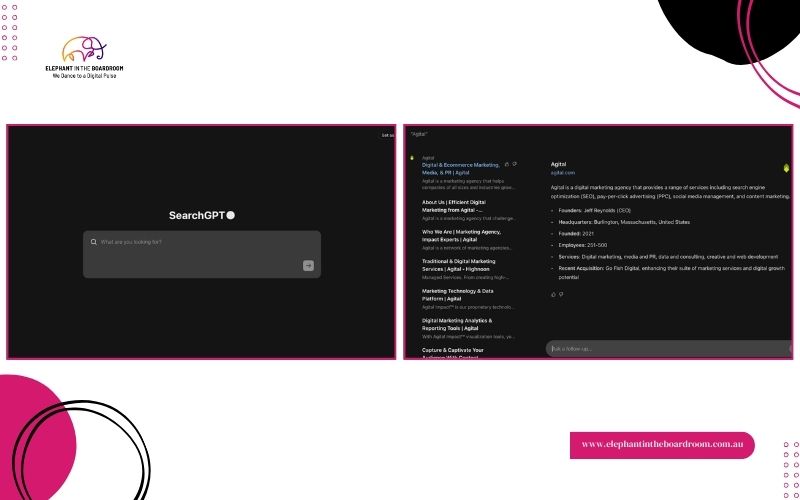
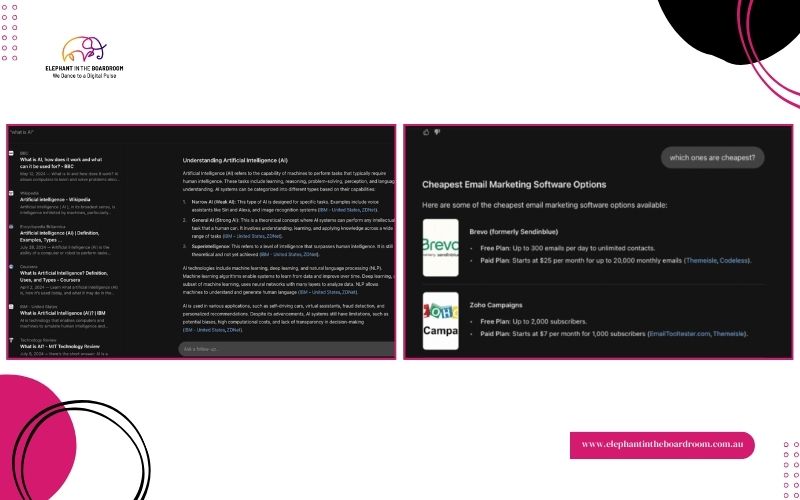
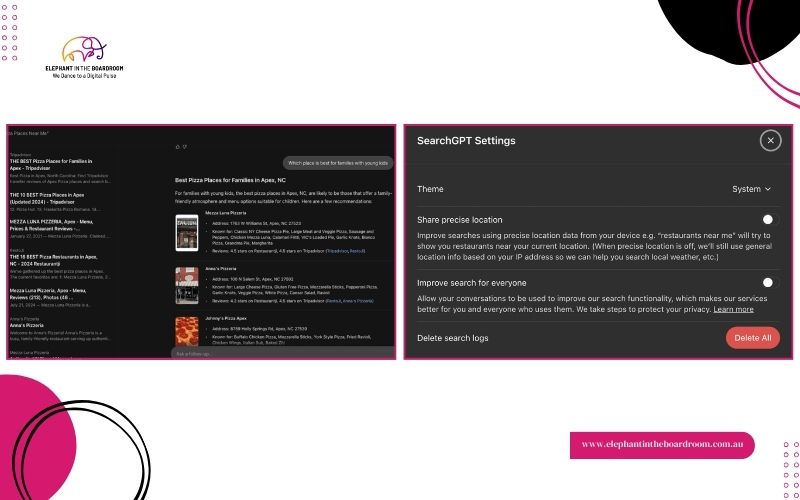
SearchGPT works through a multi-step process that begins with Natural Language Processing (NLP) to interpret and break down the user’s query, identifying its intent and context. It then uses contextual understanding to differentiate between similar terms and nuances.
To find the most relevant details, the engine interprets through a variety of data sources, such as text documents, web pages, and structured databases. To improve its efficiency over time, it continuously learns from fresh data and user interactions and concludes in the generation of a thorough response specifically customised to the study.
Key Features of the SearchGPT Search Engine
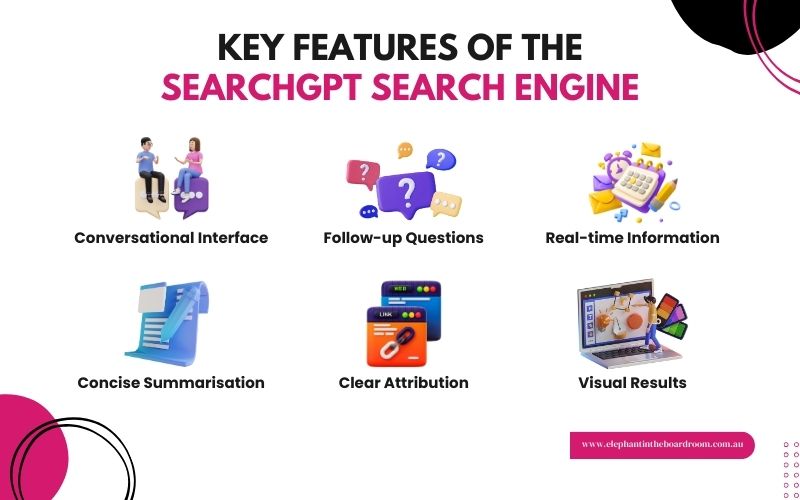
SearchGPT offers a comprehensive set of features designed to enhance the search experience and provide users with more accurate and informative results. The following are the key features of SearchGPT:
Conversational Interface
SearchGPT provides a natural language interface, allowing users to ask questions in a conversational manner, similar to interacting with a human.
Follow-up Questions
Users can ask follow-up questions to delve deeper into a topic, creating a more interactive and engaging search experience.
Real-time Information
SearchGPT leverages real-time data from the web to deliver up-to-date information, ensuring that users always have access to the most current knowledge.
Concise Summaries
Instead of simply listing links, SearchGPT provides concise summaries of relevant information, saving users time and effort.
Clear Attribution
SearchGPT includes clear attributions and source links, allowing users to verify the information and explore further details on the original websites.
Visual Results
To provide a richer understanding, SearchGPT offers visual results in the form of images and videos, making it easier to comprehend complex information.
Comparing SearchGPT with Other Search Engines
Perplexity AI, with 67.42 million total visits, and ChatGPT, attracting 260.2 million monthly visitors, demonstrate the growing demand for AI-powered information retrieval. As SearchGPT enters the scene, SearchGPT needs to make a name for itself amid these well-established competitors by providing standout benefits.
SearchGPT vs. Google
SearchGPT offers a more conversational and interactive search experience compared to Google. Unlike Google's traditional keyword-based approach that provides a list of links, SearchGPT uses natural language processing to deliver direct answers, cite sources, and understand the intent behind queries, even if they are complex or ambiguous.
It maintains context across multiple interactions, creating a dynamic, personalised search experience. Additionally, SearchGPT focuses on providing real-time, accurate information, whereas Google's results, while comprehensive, may sometimes include outdated or irrelevant content.
SearchGPT vs. AI Overviews
SearchGPT and AI Overviews both use AI to summarise information and provide direct answers. Both tools deliver direct answers to user queries, aiming to save time by presenting condensed overviews rather than just a list of links.
However, SearchGPT focuses more on in-depth research and transparent sourcing, making it suitable for users seeking comprehensive insights, while AI Overviews are made for those who need quick summaries and introductory content. Both platforms are in active development, and their features and functionalities may evolve and converge over time.
SearchGPT vs. ChatGPT
SearchGPT and ChatGPT, both developed by OpenAI, share a conversational interface and foundation in advanced language models. However, SearchGPT is designed for real-time search queries with clear source attributions, while ChatGPT focuses on generating human-like conversational responses.
SearchGPT vs. Perplexity
SearchGPT and Perplexity are AI-driven search engines with conversational interfaces that refine search processes. While both enhance user interactions, SearchGPT excels in providing quick answers and real-time information, making it ideal for immediate needs. In contrast, Perplexity focuses on in-depth research, offering access to scholarly sources and a feature-rich interface for comprehensive investigations.
Enhancing eCommerce and Business Growth with SearchGPT
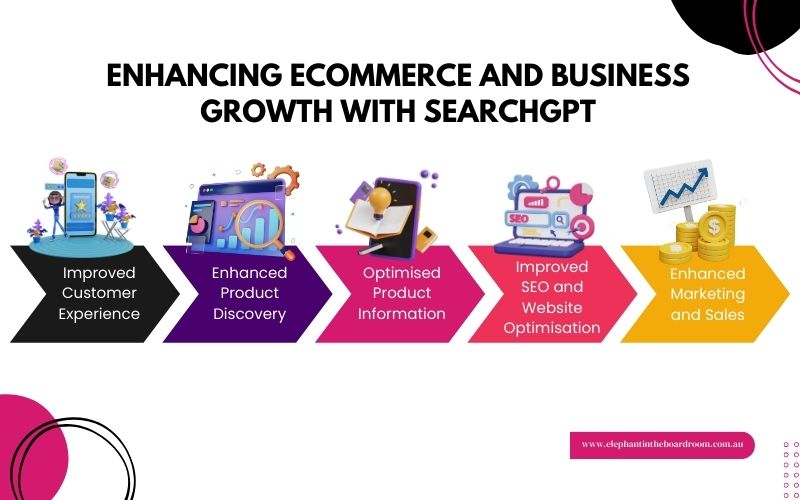
SearchGPT, with its advanced AI capabilities and conversational interface, offers significant potential to revolutionise eCommerce and drive business growth. By providing a more intuitive and engaging search experience, SearchGPT can enhance customer satisfaction, increase conversions, and ultimately boost revenue.
Here are some key ways in which SearchGPT can be used to enhance eCommerce platforms and business growth:
Improved Customer Experience
- Personalised search- SearchGPT can provide highly personalised search results based on individual customer preferences, browsing history, and purchase behaviour.
- Conversational support- By integrating SearchGPT into customer support channels, businesses can offer 24/7 assistance, addressing customer queries and concerns in a timely and efficient manner.
Enhanced Product Discovery
- Semantic search- SearchGPT's understanding of natural language allows it to comprehend complex search queries, leading to more accurate and relevant product suggestions.
- Visual search- By enabling visual search capabilities, SearchGPT can help customers find products based on images, making the shopping experience more intuitive.
Optimised Product Information
- Automatic content generation- SearchGPT can be used to generate product descriptions, meta tags, and other content, ensuring that product information is accurate, engaging, and optimised for search engines.
Improved SEO and Website Optimisation
- Keyword Research- SearchGPT can assist in identifying relevant keywords and phrases for SEO & digital marketing, helping businesses optimise their website content for search engines.
- On-Page Optimisation- By suggesting improvements to on-page elements such as titles, meta descriptions, and header tags, SearchGPT can contribute to better search engine rankings.
Enhanced Marketing and Sales
- Targeted marketing campaigns- SearchGPT can help businesses create targeted marketing campaigns based on customer preferences, demographics, and purchase history.
- Sales lead generation- By analysing customer behaviour and identifying potential leads, SearchGPT can contribute to increased sales and revenue.
Optimising Your Visibility with SearchGPT Search Engine
Staying visible and relevant online is important for businesses and individuals alike. With the emergence of AI-powered search engines like SearchGPT, new opportunities for enhanced visibility and engagement are emerging.
Here are the ways how you can optimise your visibility using SearchGPT:
Use Real-Time Information
Utilise SearchGPT’s ability to access and provide up-to-date information to ensure your content remains relevant and timely.
Enhance Transparency
Take advantage of SearchGPT’s clear source attribution to build trust with your audience by linking directly to credible and authoritative sources.
Utilise Conversational Interface
Engage with users through SearchGPT’s natural language capabilities, allowing for more personalised and interactive experiences.
Focus on Summarisation
Benefit from concise summaries that make your content easily digestible and more likely to be featured prominently in search results.
Incorporate Visual Results
Use visual elements such as images and videos to attract attention and enhance user engagement in search results.
Monitor Performance
Track how your content is performing with SearchGPT to refine your strategies and improve visibility based on real-time data insights for the data analysis.
Be Ready for the Future of Search with SearchGPT
The future of search is rapidly evolving, and SearchGPT is leading the way with innovative AI-driven technology. By offering more intuitive, conversational, and context-rich results, it’s transforming how users find information.
As businesses and individuals alike prepare for this shift, staying ahead of the curve with SearchGPT can unlock new opportunities for discovery, engagement, and efficiency.
This presents an opportunity for your business to optimise your visibility and drive growth as SearchGPT sets new standards in search innovation. Keep an eye out for updates and learn more about how you can benefit from its cutting-edge features.
Talk with us today to explore how we can help you integrate SearchGPT into your strategy and maximise your digital impact. Let’s lead the future of search together—your competitive advantage starts here.

Last 25th July, OpenAI announced the SearchGPT search engine, a new AI search prototype that shifts the paradigm from keyword-based search to conversational search. This innovative model aims to offer a more intuitive and contextually aware search experience.
But as SearchGPT steps onto the stage, intriguing questions linger in the air. Can SearchGPT truly outshine other search engines? Will it truly respect the integrity of journalism and publishers? And most importantly, can it stay away from the mistakes that other AI attempts have made?
Let’s discover if SearchGPT is the next big thing or merely a fleeting trend. Learn about SearchGPT's features and potential, and how they can be optimised for brand visibility. Explore how this new tool could be used for enhanced engagement and growth in the digital landscape.
What’s Inside:
- SearchGPT Search Engine Overview
- Key Features of the SearchGPT Search Engine
- Comparing SearchGPT with Other AI-Search Platforms
- Enhancing eCommerce and Business Growth with SearchGPT
- Optimising Your Visibility with SearchGPT Search Engine
- Be Ready for the Future of Search with SearchGPT!
SearchGPT Search Engine Overview
What is SearchGPT Search Engine?
SearchGPT search engine is an advanced platform that combines cutting-edge technologies like natural language processing (NLP), machine learning algorithms, and large datasets to deliver precise and contextually appropriate search results. It moves beyond simple keyword matching, aiming to understand the context of user queries to generate human-like responses rather than just a list of links.
How Does SearchGPT Search Engine Work?



SearchGPT works through a multi-step process that begins with Natural Language Processing (NLP) to interpret and break down the user’s query, identifying its intent and context. It then uses contextual understanding to differentiate between similar terms and nuances.
To find the most relevant details, the engine interprets through a variety of data sources, such as text documents, web pages, and structured databases. To improve its efficiency over time, it continuously learns from fresh data and user interactions and concludes in the generation of a thorough response specifically customised to the study.
Key Features of the SearchGPT Search Engine

SearchGPT offers a comprehensive set of features designed to enhance the search experience and provide users with more accurate and informative results. The following are the key features of SearchGPT:
Conversational Interface
SearchGPT provides a natural language interface, allowing users to ask questions in a conversational manner, similar to interacting with a human.
Follow-up Questions
Users can ask follow-up questions to delve deeper into a topic, creating a more interactive and engaging search experience.
Real-time Information
SearchGPT leverages real-time data from the web to deliver up-to-date information, ensuring that users always have access to the most current knowledge.
Concise Summaries
Instead of simply listing links, SearchGPT provides concise summaries of relevant information, saving users time and effort.
Clear Attribution
SearchGPT includes clear attributions and source links, allowing users to verify the information and explore further details on the original websites.
Visual Results
To provide a richer understanding, SearchGPT offers visual results in the form of images and videos, making it easier to comprehend complex information.
Comparing SearchGPT with Other Search Engines
Perplexity AI, with 67.42 million total visits, and ChatGPT, attracting 260.2 million monthly visitors, demonstrate the growing demand for AI-powered information retrieval. As SearchGPT enters the scene, SearchGPT needs to make a name for itself amid these well-established competitors by providing standout benefits.
SearchGPT vs. Google
SearchGPT offers a more conversational and interactive search experience compared to Google. Unlike Google's traditional keyword-based approach that provides a list of links, SearchGPT uses natural language processing to deliver direct answers, cite sources, and understand the intent behind queries, even if they are complex or ambiguous.
It maintains context across multiple interactions, creating a dynamic, personalised search experience. Additionally, SearchGPT focuses on providing real-time, accurate information, whereas Google's results, while comprehensive, may sometimes include outdated or irrelevant content.
SearchGPT vs. AI Overviews
SearchGPT and AI Overviews both use AI to summarise information and provide direct answers. Both tools deliver direct answers to user queries, aiming to save time by presenting condensed overviews rather than just a list of links.
However, SearchGPT focuses more on in-depth research and transparent sourcing, making it suitable for users seeking comprehensive insights, while AI Overviews are made for those who need quick summaries and introductory content. Both platforms are in active development, and their features and functionalities may evolve and converge over time.
SearchGPT vs. ChatGPT
SearchGPT and ChatGPT, both developed by OpenAI, share a conversational interface and foundation in advanced language models. However, SearchGPT is designed for real-time search queries with clear source attributions, while ChatGPT focuses on generating human-like conversational responses.
SearchGPT vs. Perplexity
SearchGPT and Perplexity are AI-driven search engines with conversational interfaces that refine search processes. While both enhance user interactions, SearchGPT excels in providing quick answers and real-time information, making it ideal for immediate needs. In contrast, Perplexity focuses on in-depth research, offering access to scholarly sources and a feature-rich interface for comprehensive investigations.
Enhancing eCommerce and Business Growth with SearchGPT

SearchGPT, with its advanced AI capabilities and conversational interface, offers significant potential to revolutionise eCommerce and drive business growth. By providing a more intuitive and engaging search experience, SearchGPT can enhance customer satisfaction, increase conversions, and ultimately boost revenue.
Here are some key ways in which SearchGPT can be used to enhance eCommerce platforms and business growth:
Improved Customer Experience
- Personalised search- SearchGPT can provide highly personalised search results based on individual customer preferences, browsing history, and purchase behaviour.
- Conversational support- By integrating SearchGPT into customer support channels, businesses can offer 24/7 assistance, addressing customer queries and concerns in a timely and efficient manner.
Enhanced Product Discovery
- Semantic search- SearchGPT's understanding of natural language allows it to comprehend complex search queries, leading to more accurate and relevant product suggestions.
- Visual search- By enabling visual search capabilities, SearchGPT can help customers find products based on images, making the shopping experience more intuitive.
Optimised Product Information
- Automatic content generation- SearchGPT can be used to generate product descriptions, meta tags, and other content, ensuring that product information is accurate, engaging, and optimised for search engines.
Improved SEO and Website Optimisation
- Keyword Research- SearchGPT can assist in identifying relevant keywords and phrases for SEO & digital marketing, helping businesses optimise their website content for search engines.
- On-Page Optimisation- By suggesting improvements to on-page elements such as titles, meta descriptions, and header tags, SearchGPT can contribute to better search engine rankings.
Enhanced Marketing and Sales
- Targeted marketing campaigns- SearchGPT can help businesses create targeted marketing campaigns based on customer preferences, demographics, and purchase history.
- Sales lead generation- By analysing customer behaviour and identifying potential leads, SearchGPT can contribute to increased sales and revenue.
Optimising Your Visibility with SearchGPT Search Engine
Staying visible and relevant online is important for businesses and individuals alike. With the emergence of AI-powered search engines like SearchGPT, new opportunities for enhanced visibility and engagement are emerging.
Here are the ways how you can optimise your visibility using SearchGPT:
Use Real-Time Information
Utilise SearchGPT’s ability to access and provide up-to-date information to ensure your content remains relevant and timely.
Enhance Transparency
Take advantage of SearchGPT’s clear source attribution to build trust with your audience by linking directly to credible and authoritative sources.
Utilise Conversational Interface
Engage with users through SearchGPT’s natural language capabilities, allowing for more personalised and interactive experiences.
Focus on Summarisation
Benefit from concise summaries that make your content easily digestible and more likely to be featured prominently in search results.
Incorporate Visual Results
Use visual elements such as images and videos to attract attention and enhance user engagement in search results.
Monitor Performance
Track how your content is performing with SearchGPT to refine your strategies and improve visibility based on real-time data insights for the data analysis.
Be Ready for the Future of Search with SearchGPT
The future of search is rapidly evolving, and SearchGPT is leading the way with innovative AI-driven technology. By offering more intuitive, conversational, and context-rich results, it’s transforming how users find information.
As businesses and individuals alike prepare for this shift, staying ahead of the curve with SearchGPT can unlock new opportunities for discovery, engagement, and efficiency.
This presents an opportunity for your business to optimise your visibility and drive growth as SearchGPT sets new standards in search innovation. Keep an eye out for updates and learn more about how you can benefit from its cutting-edge features.
Talk with us today to explore how we can help you integrate SearchGPT into your strategy and maximise your digital impact. Let’s lead the future of search together—your competitive advantage starts here.

Last 25th July, OpenAI announced the SearchGPT search engine, a new AI search prototype that shifts the paradigm from keyword-based search to conversational search. This innovative model aims to offer a more intuitive and contextually aware search experience.
But as SearchGPT steps onto the stage, intriguing questions linger in the air. Can SearchGPT truly outshine other search engines? Will it truly respect the integrity of journalism and publishers? And most importantly, can it stay away from the mistakes that other AI attempts have made?
Let’s discover if SearchGPT is the next big thing or merely a fleeting trend. Learn about SearchGPT's features and potential, and how they can be optimised for brand visibility. Explore how this new tool could be used for enhanced engagement and growth in the digital landscape.
What’s Inside:
- SearchGPT Search Engine Overview
- Key Features of the SearchGPT Search Engine
- Comparing SearchGPT with Other AI-Search Platforms
- Enhancing eCommerce and Business Growth with SearchGPT
- Optimising Your Visibility with SearchGPT Search Engine
- Be Ready for the Future of Search with SearchGPT!
SearchGPT Search Engine Overview
What is SearchGPT Search Engine?
SearchGPT search engine is an advanced platform that combines cutting-edge technologies like natural language processing (NLP), machine learning algorithms, and large datasets to deliver precise and contextually appropriate search results. It moves beyond simple keyword matching, aiming to understand the context of user queries to generate human-like responses rather than just a list of links.
How Does SearchGPT Search Engine Work?



SearchGPT works through a multi-step process that begins with Natural Language Processing (NLP) to interpret and break down the user’s query, identifying its intent and context. It then uses contextual understanding to differentiate between similar terms and nuances.
To find the most relevant details, the engine interprets through a variety of data sources, such as text documents, web pages, and structured databases. To improve its efficiency over time, it continuously learns from fresh data and user interactions and concludes in the generation of a thorough response specifically customised to the study.
Key Features of the SearchGPT Search Engine

SearchGPT offers a comprehensive set of features designed to enhance the search experience and provide users with more accurate and informative results. The following are the key features of SearchGPT:
Conversational Interface
SearchGPT provides a natural language interface, allowing users to ask questions in a conversational manner, similar to interacting with a human.
Follow-up Questions
Users can ask follow-up questions to delve deeper into a topic, creating a more interactive and engaging search experience.
Real-time Information
SearchGPT leverages real-time data from the web to deliver up-to-date information, ensuring that users always have access to the most current knowledge.
Concise Summaries
Instead of simply listing links, SearchGPT provides concise summaries of relevant information, saving users time and effort.
Clear Attribution
SearchGPT includes clear attributions and source links, allowing users to verify the information and explore further details on the original websites.
Visual Results
To provide a richer understanding, SearchGPT offers visual results in the form of images and videos, making it easier to comprehend complex information.
Comparing SearchGPT with Other Search Engines
Perplexity AI, with 67.42 million total visits, and ChatGPT, attracting 260.2 million monthly visitors, demonstrate the growing demand for AI-powered information retrieval. As SearchGPT enters the scene, SearchGPT needs to make a name for itself amid these well-established competitors by providing standout benefits.
SearchGPT vs. Google
SearchGPT offers a more conversational and interactive search experience compared to Google. Unlike Google's traditional keyword-based approach that provides a list of links, SearchGPT uses natural language processing to deliver direct answers, cite sources, and understand the intent behind queries, even if they are complex or ambiguous.
It maintains context across multiple interactions, creating a dynamic, personalised search experience. Additionally, SearchGPT focuses on providing real-time, accurate information, whereas Google's results, while comprehensive, may sometimes include outdated or irrelevant content.
SearchGPT vs. AI Overviews
SearchGPT and AI Overviews both use AI to summarise information and provide direct answers. Both tools deliver direct answers to user queries, aiming to save time by presenting condensed overviews rather than just a list of links.
However, SearchGPT focuses more on in-depth research and transparent sourcing, making it suitable for users seeking comprehensive insights, while AI Overviews are made for those who need quick summaries and introductory content. Both platforms are in active development, and their features and functionalities may evolve and converge over time.
SearchGPT vs. ChatGPT
SearchGPT and ChatGPT, both developed by OpenAI, share a conversational interface and foundation in advanced language models. However, SearchGPT is designed for real-time search queries with clear source attributions, while ChatGPT focuses on generating human-like conversational responses.
SearchGPT vs. Perplexity
SearchGPT and Perplexity are AI-driven search engines with conversational interfaces that refine search processes. While both enhance user interactions, SearchGPT excels in providing quick answers and real-time information, making it ideal for immediate needs. In contrast, Perplexity focuses on in-depth research, offering access to scholarly sources and a feature-rich interface for comprehensive investigations.
Enhancing eCommerce and Business Growth with SearchGPT

SearchGPT, with its advanced AI capabilities and conversational interface, offers significant potential to revolutionise eCommerce and drive business growth. By providing a more intuitive and engaging search experience, SearchGPT can enhance customer satisfaction, increase conversions, and ultimately boost revenue.
Here are some key ways in which SearchGPT can be used to enhance eCommerce platforms and business growth:
Improved Customer Experience
- Personalised search- SearchGPT can provide highly personalised search results based on individual customer preferences, browsing history, and purchase behaviour.
- Conversational support- By integrating SearchGPT into customer support channels, businesses can offer 24/7 assistance, addressing customer queries and concerns in a timely and efficient manner.
Enhanced Product Discovery
- Semantic search- SearchGPT's understanding of natural language allows it to comprehend complex search queries, leading to more accurate and relevant product suggestions.
- Visual search- By enabling visual search capabilities, SearchGPT can help customers find products based on images, making the shopping experience more intuitive.
Optimised Product Information
- Automatic content generation- SearchGPT can be used to generate product descriptions, meta tags, and other content, ensuring that product information is accurate, engaging, and optimised for search engines.
Improved SEO and Website Optimisation
- Keyword Research- SearchGPT can assist in identifying relevant keywords and phrases for SEO & digital marketing, helping businesses optimise their website content for search engines.
- On-Page Optimisation- By suggesting improvements to on-page elements such as titles, meta descriptions, and header tags, SearchGPT can contribute to better search engine rankings.
Enhanced Marketing and Sales
- Targeted marketing campaigns- SearchGPT can help businesses create targeted marketing campaigns based on customer preferences, demographics, and purchase history.
- Sales lead generation- By analysing customer behaviour and identifying potential leads, SearchGPT can contribute to increased sales and revenue.
Optimising Your Visibility with SearchGPT Search Engine
Staying visible and relevant online is important for businesses and individuals alike. With the emergence of AI-powered search engines like SearchGPT, new opportunities for enhanced visibility and engagement are emerging.
Here are the ways how you can optimise your visibility using SearchGPT:
Use Real-Time Information
Utilise SearchGPT’s ability to access and provide up-to-date information to ensure your content remains relevant and timely.
Enhance Transparency
Take advantage of SearchGPT’s clear source attribution to build trust with your audience by linking directly to credible and authoritative sources.
Utilise Conversational Interface
Engage with users through SearchGPT’s natural language capabilities, allowing for more personalised and interactive experiences.
Focus on Summarisation
Benefit from concise summaries that make your content easily digestible and more likely to be featured prominently in search results.
Incorporate Visual Results
Use visual elements such as images and videos to attract attention and enhance user engagement in search results.
Monitor Performance
Track how your content is performing with SearchGPT to refine your strategies and improve visibility based on real-time data insights for the data analysis.
Be Ready for the Future of Search with SearchGPT
The future of search is rapidly evolving, and SearchGPT is leading the way with innovative AI-driven technology. By offering more intuitive, conversational, and context-rich results, it’s transforming how users find information.
As businesses and individuals alike prepare for this shift, staying ahead of the curve with SearchGPT can unlock new opportunities for discovery, engagement, and efficiency.
This presents an opportunity for your business to optimise your visibility and drive growth as SearchGPT sets new standards in search innovation. Keep an eye out for updates and learn more about how you can benefit from its cutting-edge features.
Talk with us today to explore how we can help you integrate SearchGPT into your strategy and maximise your digital impact. Let’s lead the future of search together—your competitive advantage starts here.

Last 25th July, OpenAI announced the SearchGPT search engine, a new AI search prototype that shifts the paradigm from keyword-based search to conversational search. This innovative model aims to offer a more intuitive and contextually aware search experience.
But as SearchGPT steps onto the stage, intriguing questions linger in the air. Can SearchGPT truly outshine other search engines? Will it truly respect the integrity of journalism and publishers? And most importantly, can it stay away from the mistakes that other AI attempts have made?
Let’s discover if SearchGPT is the next big thing or merely a fleeting trend. Learn about SearchGPT's features and potential, and how they can be optimised for brand visibility. Explore how this new tool could be used for enhanced engagement and growth in the digital landscape.
What’s Inside:
- SearchGPT Search Engine Overview
- Key Features of the SearchGPT Search Engine
- Comparing SearchGPT with Other AI-Search Platforms
- Enhancing eCommerce and Business Growth with SearchGPT
- Optimising Your Visibility with SearchGPT Search Engine
- Be Ready for the Future of Search with SearchGPT!
SearchGPT Search Engine Overview
What is SearchGPT Search Engine?
SearchGPT search engine is an advanced platform that combines cutting-edge technologies like natural language processing (NLP), machine learning algorithms, and large datasets to deliver precise and contextually appropriate search results. It moves beyond simple keyword matching, aiming to understand the context of user queries to generate human-like responses rather than just a list of links.
How Does SearchGPT Search Engine Work?



SearchGPT works through a multi-step process that begins with Natural Language Processing (NLP) to interpret and break down the user’s query, identifying its intent and context. It then uses contextual understanding to differentiate between similar terms and nuances.
To find the most relevant details, the engine interprets through a variety of data sources, such as text documents, web pages, and structured databases. To improve its efficiency over time, it continuously learns from fresh data and user interactions and concludes in the generation of a thorough response specifically customised to the study.
Key Features of the SearchGPT Search Engine

SearchGPT offers a comprehensive set of features designed to enhance the search experience and provide users with more accurate and informative results. The following are the key features of SearchGPT:
Conversational Interface
SearchGPT provides a natural language interface, allowing users to ask questions in a conversational manner, similar to interacting with a human.
Follow-up Questions
Users can ask follow-up questions to delve deeper into a topic, creating a more interactive and engaging search experience.
Real-time Information
SearchGPT leverages real-time data from the web to deliver up-to-date information, ensuring that users always have access to the most current knowledge.
Concise Summaries
Instead of simply listing links, SearchGPT provides concise summaries of relevant information, saving users time and effort.
Clear Attribution
SearchGPT includes clear attributions and source links, allowing users to verify the information and explore further details on the original websites.
Visual Results
To provide a richer understanding, SearchGPT offers visual results in the form of images and videos, making it easier to comprehend complex information.
Comparing SearchGPT with Other Search Engines
Perplexity AI, with 67.42 million total visits, and ChatGPT, attracting 260.2 million monthly visitors, demonstrate the growing demand for AI-powered information retrieval. As SearchGPT enters the scene, SearchGPT needs to make a name for itself amid these well-established competitors by providing standout benefits.
SearchGPT vs. Google
SearchGPT offers a more conversational and interactive search experience compared to Google. Unlike Google's traditional keyword-based approach that provides a list of links, SearchGPT uses natural language processing to deliver direct answers, cite sources, and understand the intent behind queries, even if they are complex or ambiguous.
It maintains context across multiple interactions, creating a dynamic, personalised search experience. Additionally, SearchGPT focuses on providing real-time, accurate information, whereas Google's results, while comprehensive, may sometimes include outdated or irrelevant content.
SearchGPT vs. AI Overviews
SearchGPT and AI Overviews both use AI to summarise information and provide direct answers. Both tools deliver direct answers to user queries, aiming to save time by presenting condensed overviews rather than just a list of links.
However, SearchGPT focuses more on in-depth research and transparent sourcing, making it suitable for users seeking comprehensive insights, while AI Overviews are made for those who need quick summaries and introductory content. Both platforms are in active development, and their features and functionalities may evolve and converge over time.
SearchGPT vs. ChatGPT
SearchGPT and ChatGPT, both developed by OpenAI, share a conversational interface and foundation in advanced language models. However, SearchGPT is designed for real-time search queries with clear source attributions, while ChatGPT focuses on generating human-like conversational responses.
SearchGPT vs. Perplexity
SearchGPT and Perplexity are AI-driven search engines with conversational interfaces that refine search processes. While both enhance user interactions, SearchGPT excels in providing quick answers and real-time information, making it ideal for immediate needs. In contrast, Perplexity focuses on in-depth research, offering access to scholarly sources and a feature-rich interface for comprehensive investigations.
Enhancing eCommerce and Business Growth with SearchGPT

SearchGPT, with its advanced AI capabilities and conversational interface, offers significant potential to revolutionise eCommerce and drive business growth. By providing a more intuitive and engaging search experience, SearchGPT can enhance customer satisfaction, increase conversions, and ultimately boost revenue.
Here are some key ways in which SearchGPT can be used to enhance eCommerce platforms and business growth:
Improved Customer Experience
- Personalised search- SearchGPT can provide highly personalised search results based on individual customer preferences, browsing history, and purchase behaviour.
- Conversational support- By integrating SearchGPT into customer support channels, businesses can offer 24/7 assistance, addressing customer queries and concerns in a timely and efficient manner.
Enhanced Product Discovery
- Semantic search- SearchGPT's understanding of natural language allows it to comprehend complex search queries, leading to more accurate and relevant product suggestions.
- Visual search- By enabling visual search capabilities, SearchGPT can help customers find products based on images, making the shopping experience more intuitive.
Optimised Product Information
- Automatic content generation- SearchGPT can be used to generate product descriptions, meta tags, and other content, ensuring that product information is accurate, engaging, and optimised for search engines.
Improved SEO and Website Optimisation
- Keyword Research- SearchGPT can assist in identifying relevant keywords and phrases for SEO & digital marketing, helping businesses optimise their website content for search engines.
- On-Page Optimisation- By suggesting improvements to on-page elements such as titles, meta descriptions, and header tags, SearchGPT can contribute to better search engine rankings.
Enhanced Marketing and Sales
- Targeted marketing campaigns- SearchGPT can help businesses create targeted marketing campaigns based on customer preferences, demographics, and purchase history.
- Sales lead generation- By analysing customer behaviour and identifying potential leads, SearchGPT can contribute to increased sales and revenue.
Optimising Your Visibility with SearchGPT Search Engine
Staying visible and relevant online is important for businesses and individuals alike. With the emergence of AI-powered search engines like SearchGPT, new opportunities for enhanced visibility and engagement are emerging.
Here are the ways how you can optimise your visibility using SearchGPT:
Use Real-Time Information
Utilise SearchGPT’s ability to access and provide up-to-date information to ensure your content remains relevant and timely.
Enhance Transparency
Take advantage of SearchGPT’s clear source attribution to build trust with your audience by linking directly to credible and authoritative sources.
Utilise Conversational Interface
Engage with users through SearchGPT’s natural language capabilities, allowing for more personalised and interactive experiences.
Focus on Summarisation
Benefit from concise summaries that make your content easily digestible and more likely to be featured prominently in search results.
Incorporate Visual Results
Use visual elements such as images and videos to attract attention and enhance user engagement in search results.
Monitor Performance
Track how your content is performing with SearchGPT to refine your strategies and improve visibility based on real-time data insights for the data analysis.
Be Ready for the Future of Search with SearchGPT
The future of search is rapidly evolving, and SearchGPT is leading the way with innovative AI-driven technology. By offering more intuitive, conversational, and context-rich results, it’s transforming how users find information.
As businesses and individuals alike prepare for this shift, staying ahead of the curve with SearchGPT can unlock new opportunities for discovery, engagement, and efficiency.
This presents an opportunity for your business to optimise your visibility and drive growth as SearchGPT sets new standards in search innovation. Keep an eye out for updates and learn more about how you can benefit from its cutting-edge features.
Talk with us today to explore how we can help you integrate SearchGPT into your strategy and maximise your digital impact. Let’s lead the future of search together—your competitive advantage starts here.

Last 25th July, OpenAI announced the SearchGPT search engine, a new AI search prototype that shifts the paradigm from keyword-based search to conversational search. This innovative model aims to offer a more intuitive and contextually aware search experience.
But as SearchGPT steps onto the stage, intriguing questions linger in the air. Can SearchGPT truly outshine other search engines? Will it truly respect the integrity of journalism and publishers? And most importantly, can it stay away from the mistakes that other AI attempts have made?
Let’s discover if SearchGPT is the next big thing or merely a fleeting trend. Learn about SearchGPT's features and potential, and how they can be optimised for brand visibility. Explore how this new tool could be used for enhanced engagement and growth in the digital landscape.
What’s Inside:
- SearchGPT Search Engine Overview
- Key Features of the SearchGPT Search Engine
- Comparing SearchGPT with Other AI-Search Platforms
- Enhancing eCommerce and Business Growth with SearchGPT
- Optimising Your Visibility with SearchGPT Search Engine
- Be Ready for the Future of Search with SearchGPT!
SearchGPT Search Engine Overview
What is SearchGPT Search Engine?
SearchGPT search engine is an advanced platform that combines cutting-edge technologies like natural language processing (NLP), machine learning algorithms, and large datasets to deliver precise and contextually appropriate search results. It moves beyond simple keyword matching, aiming to understand the context of user queries to generate human-like responses rather than just a list of links.
How Does SearchGPT Search Engine Work?



SearchGPT works through a multi-step process that begins with Natural Language Processing (NLP) to interpret and break down the user’s query, identifying its intent and context. It then uses contextual understanding to differentiate between similar terms and nuances.
To find the most relevant details, the engine interprets through a variety of data sources, such as text documents, web pages, and structured databases. To improve its efficiency over time, it continuously learns from fresh data and user interactions and concludes in the generation of a thorough response specifically customised to the study.
Key Features of the SearchGPT Search Engine

SearchGPT offers a comprehensive set of features designed to enhance the search experience and provide users with more accurate and informative results. The following are the key features of SearchGPT:
Conversational Interface
SearchGPT provides a natural language interface, allowing users to ask questions in a conversational manner, similar to interacting with a human.
Follow-up Questions
Users can ask follow-up questions to delve deeper into a topic, creating a more interactive and engaging search experience.
Real-time Information
SearchGPT leverages real-time data from the web to deliver up-to-date information, ensuring that users always have access to the most current knowledge.
Concise Summaries
Instead of simply listing links, SearchGPT provides concise summaries of relevant information, saving users time and effort.
Clear Attribution
SearchGPT includes clear attributions and source links, allowing users to verify the information and explore further details on the original websites.
Visual Results
To provide a richer understanding, SearchGPT offers visual results in the form of images and videos, making it easier to comprehend complex information.
Comparing SearchGPT with Other Search Engines
Perplexity AI, with 67.42 million total visits, and ChatGPT, attracting 260.2 million monthly visitors, demonstrate the growing demand for AI-powered information retrieval. As SearchGPT enters the scene, SearchGPT needs to make a name for itself amid these well-established competitors by providing standout benefits.
SearchGPT vs. Google
SearchGPT offers a more conversational and interactive search experience compared to Google. Unlike Google's traditional keyword-based approach that provides a list of links, SearchGPT uses natural language processing to deliver direct answers, cite sources, and understand the intent behind queries, even if they are complex or ambiguous.
It maintains context across multiple interactions, creating a dynamic, personalised search experience. Additionally, SearchGPT focuses on providing real-time, accurate information, whereas Google's results, while comprehensive, may sometimes include outdated or irrelevant content.
SearchGPT vs. AI Overviews
SearchGPT and AI Overviews both use AI to summarise information and provide direct answers. Both tools deliver direct answers to user queries, aiming to save time by presenting condensed overviews rather than just a list of links.
However, SearchGPT focuses more on in-depth research and transparent sourcing, making it suitable for users seeking comprehensive insights, while AI Overviews are made for those who need quick summaries and introductory content. Both platforms are in active development, and their features and functionalities may evolve and converge over time.
SearchGPT vs. ChatGPT
SearchGPT and ChatGPT, both developed by OpenAI, share a conversational interface and foundation in advanced language models. However, SearchGPT is designed for real-time search queries with clear source attributions, while ChatGPT focuses on generating human-like conversational responses.
SearchGPT vs. Perplexity
SearchGPT and Perplexity are AI-driven search engines with conversational interfaces that refine search processes. While both enhance user interactions, SearchGPT excels in providing quick answers and real-time information, making it ideal for immediate needs. In contrast, Perplexity focuses on in-depth research, offering access to scholarly sources and a feature-rich interface for comprehensive investigations.
Enhancing eCommerce and Business Growth with SearchGPT

SearchGPT, with its advanced AI capabilities and conversational interface, offers significant potential to revolutionise eCommerce and drive business growth. By providing a more intuitive and engaging search experience, SearchGPT can enhance customer satisfaction, increase conversions, and ultimately boost revenue.
Here are some key ways in which SearchGPT can be used to enhance eCommerce platforms and business growth:
Improved Customer Experience
- Personalised search- SearchGPT can provide highly personalised search results based on individual customer preferences, browsing history, and purchase behaviour.
- Conversational support- By integrating SearchGPT into customer support channels, businesses can offer 24/7 assistance, addressing customer queries and concerns in a timely and efficient manner.
Enhanced Product Discovery
- Semantic search- SearchGPT's understanding of natural language allows it to comprehend complex search queries, leading to more accurate and relevant product suggestions.
- Visual search- By enabling visual search capabilities, SearchGPT can help customers find products based on images, making the shopping experience more intuitive.
Optimised Product Information
- Automatic content generation- SearchGPT can be used to generate product descriptions, meta tags, and other content, ensuring that product information is accurate, engaging, and optimised for search engines.
Improved SEO and Website Optimisation
- Keyword Research- SearchGPT can assist in identifying relevant keywords and phrases for SEO & digital marketing, helping businesses optimise their website content for search engines.
- On-Page Optimisation- By suggesting improvements to on-page elements such as titles, meta descriptions, and header tags, SearchGPT can contribute to better search engine rankings.
Enhanced Marketing and Sales
- Targeted marketing campaigns- SearchGPT can help businesses create targeted marketing campaigns based on customer preferences, demographics, and purchase history.
- Sales lead generation- By analysing customer behaviour and identifying potential leads, SearchGPT can contribute to increased sales and revenue.
Optimising Your Visibility with SearchGPT Search Engine
Staying visible and relevant online is important for businesses and individuals alike. With the emergence of AI-powered search engines like SearchGPT, new opportunities for enhanced visibility and engagement are emerging.
Here are the ways how you can optimise your visibility using SearchGPT:
Use Real-Time Information
Utilise SearchGPT’s ability to access and provide up-to-date information to ensure your content remains relevant and timely.
Enhance Transparency
Take advantage of SearchGPT’s clear source attribution to build trust with your audience by linking directly to credible and authoritative sources.
Utilise Conversational Interface
Engage with users through SearchGPT’s natural language capabilities, allowing for more personalised and interactive experiences.
Focus on Summarisation
Benefit from concise summaries that make your content easily digestible and more likely to be featured prominently in search results.
Incorporate Visual Results
Use visual elements such as images and videos to attract attention and enhance user engagement in search results.
Monitor Performance
Track how your content is performing with SearchGPT to refine your strategies and improve visibility based on real-time data insights for the data analysis.
Be Ready for the Future of Search with SearchGPT
The future of search is rapidly evolving, and SearchGPT is leading the way with innovative AI-driven technology. By offering more intuitive, conversational, and context-rich results, it’s transforming how users find information.
As businesses and individuals alike prepare for this shift, staying ahead of the curve with SearchGPT can unlock new opportunities for discovery, engagement, and efficiency.
This presents an opportunity for your business to optimise your visibility and drive growth as SearchGPT sets new standards in search innovation. Keep an eye out for updates and learn more about how you can benefit from its cutting-edge features.
Talk with us today to explore how we can help you integrate SearchGPT into your strategy and maximise your digital impact. Let’s lead the future of search together—your competitive advantage starts here.

Last 25th July, OpenAI announced the SearchGPT search engine, a new AI search prototype that shifts the paradigm from keyword-based search to conversational search. This innovative model aims to offer a more intuitive and contextually aware search experience.
But as SearchGPT steps onto the stage, intriguing questions linger in the air. Can SearchGPT truly outshine other search engines? Will it truly respect the integrity of journalism and publishers? And most importantly, can it stay away from the mistakes that other AI attempts have made?
Let’s discover if SearchGPT is the next big thing or merely a fleeting trend. Learn about SearchGPT's features and potential, and how they can be optimised for brand visibility. Explore how this new tool could be used for enhanced engagement and growth in the digital landscape.
What’s Inside:
- SearchGPT Search Engine Overview
- Key Features of the SearchGPT Search Engine
- Comparing SearchGPT with Other AI-Search Platforms
- Enhancing eCommerce and Business Growth with SearchGPT
- Optimising Your Visibility with SearchGPT Search Engine
- Be Ready for the Future of Search with SearchGPT!
SearchGPT Search Engine Overview
What is SearchGPT Search Engine?
SearchGPT search engine is an advanced platform that combines cutting-edge technologies like natural language processing (NLP), machine learning algorithms, and large datasets to deliver precise and contextually appropriate search results. It moves beyond simple keyword matching, aiming to understand the context of user queries to generate human-like responses rather than just a list of links.
How Does SearchGPT Search Engine Work?



SearchGPT works through a multi-step process that begins with Natural Language Processing (NLP) to interpret and break down the user’s query, identifying its intent and context. It then uses contextual understanding to differentiate between similar terms and nuances.
To find the most relevant details, the engine interprets through a variety of data sources, such as text documents, web pages, and structured databases. To improve its efficiency over time, it continuously learns from fresh data and user interactions and concludes in the generation of a thorough response specifically customised to the study.
Key Features of the SearchGPT Search Engine

SearchGPT offers a comprehensive set of features designed to enhance the search experience and provide users with more accurate and informative results. The following are the key features of SearchGPT:
Conversational Interface
SearchGPT provides a natural language interface, allowing users to ask questions in a conversational manner, similar to interacting with a human.
Follow-up Questions
Users can ask follow-up questions to delve deeper into a topic, creating a more interactive and engaging search experience.
Real-time Information
SearchGPT leverages real-time data from the web to deliver up-to-date information, ensuring that users always have access to the most current knowledge.
Concise Summaries
Instead of simply listing links, SearchGPT provides concise summaries of relevant information, saving users time and effort.
Clear Attribution
SearchGPT includes clear attributions and source links, allowing users to verify the information and explore further details on the original websites.
Visual Results
To provide a richer understanding, SearchGPT offers visual results in the form of images and videos, making it easier to comprehend complex information.
Comparing SearchGPT with Other Search Engines
Perplexity AI, with 67.42 million total visits, and ChatGPT, attracting 260.2 million monthly visitors, demonstrate the growing demand for AI-powered information retrieval. As SearchGPT enters the scene, SearchGPT needs to make a name for itself amid these well-established competitors by providing standout benefits.
SearchGPT vs. Google
SearchGPT offers a more conversational and interactive search experience compared to Google. Unlike Google's traditional keyword-based approach that provides a list of links, SearchGPT uses natural language processing to deliver direct answers, cite sources, and understand the intent behind queries, even if they are complex or ambiguous.
It maintains context across multiple interactions, creating a dynamic, personalised search experience. Additionally, SearchGPT focuses on providing real-time, accurate information, whereas Google's results, while comprehensive, may sometimes include outdated or irrelevant content.
SearchGPT vs. AI Overviews
SearchGPT and AI Overviews both use AI to summarise information and provide direct answers. Both tools deliver direct answers to user queries, aiming to save time by presenting condensed overviews rather than just a list of links.
However, SearchGPT focuses more on in-depth research and transparent sourcing, making it suitable for users seeking comprehensive insights, while AI Overviews are made for those who need quick summaries and introductory content. Both platforms are in active development, and their features and functionalities may evolve and converge over time.
SearchGPT vs. ChatGPT
SearchGPT and ChatGPT, both developed by OpenAI, share a conversational interface and foundation in advanced language models. However, SearchGPT is designed for real-time search queries with clear source attributions, while ChatGPT focuses on generating human-like conversational responses.
SearchGPT vs. Perplexity
SearchGPT and Perplexity are AI-driven search engines with conversational interfaces that refine search processes. While both enhance user interactions, SearchGPT excels in providing quick answers and real-time information, making it ideal for immediate needs. In contrast, Perplexity focuses on in-depth research, offering access to scholarly sources and a feature-rich interface for comprehensive investigations.
Enhancing eCommerce and Business Growth with SearchGPT

SearchGPT, with its advanced AI capabilities and conversational interface, offers significant potential to revolutionise eCommerce and drive business growth. By providing a more intuitive and engaging search experience, SearchGPT can enhance customer satisfaction, increase conversions, and ultimately boost revenue.
Here are some key ways in which SearchGPT can be used to enhance eCommerce platforms and business growth:
Improved Customer Experience
- Personalised search- SearchGPT can provide highly personalised search results based on individual customer preferences, browsing history, and purchase behaviour.
- Conversational support- By integrating SearchGPT into customer support channels, businesses can offer 24/7 assistance, addressing customer queries and concerns in a timely and efficient manner.
Enhanced Product Discovery
- Semantic search- SearchGPT's understanding of natural language allows it to comprehend complex search queries, leading to more accurate and relevant product suggestions.
- Visual search- By enabling visual search capabilities, SearchGPT can help customers find products based on images, making the shopping experience more intuitive.
Optimised Product Information
- Automatic content generation- SearchGPT can be used to generate product descriptions, meta tags, and other content, ensuring that product information is accurate, engaging, and optimised for search engines.
Improved SEO and Website Optimisation
- Keyword Research- SearchGPT can assist in identifying relevant keywords and phrases for SEO & digital marketing, helping businesses optimise their website content for search engines.
- On-Page Optimisation- By suggesting improvements to on-page elements such as titles, meta descriptions, and header tags, SearchGPT can contribute to better search engine rankings.
Enhanced Marketing and Sales
- Targeted marketing campaigns- SearchGPT can help businesses create targeted marketing campaigns based on customer preferences, demographics, and purchase history.
- Sales lead generation- By analysing customer behaviour and identifying potential leads, SearchGPT can contribute to increased sales and revenue.
Optimising Your Visibility with SearchGPT Search Engine
Staying visible and relevant online is important for businesses and individuals alike. With the emergence of AI-powered search engines like SearchGPT, new opportunities for enhanced visibility and engagement are emerging.
Here are the ways how you can optimise your visibility using SearchGPT:
Use Real-Time Information
Utilise SearchGPT’s ability to access and provide up-to-date information to ensure your content remains relevant and timely.
Enhance Transparency
Take advantage of SearchGPT’s clear source attribution to build trust with your audience by linking directly to credible and authoritative sources.
Utilise Conversational Interface
Engage with users through SearchGPT’s natural language capabilities, allowing for more personalised and interactive experiences.
Focus on Summarisation
Benefit from concise summaries that make your content easily digestible and more likely to be featured prominently in search results.
Incorporate Visual Results
Use visual elements such as images and videos to attract attention and enhance user engagement in search results.
Monitor Performance
Track how your content is performing with SearchGPT to refine your strategies and improve visibility based on real-time data insights for the data analysis.
Be Ready for the Future of Search with SearchGPT
The future of search is rapidly evolving, and SearchGPT is leading the way with innovative AI-driven technology. By offering more intuitive, conversational, and context-rich results, it’s transforming how users find information.
As businesses and individuals alike prepare for this shift, staying ahead of the curve with SearchGPT can unlock new opportunities for discovery, engagement, and efficiency.
This presents an opportunity for your business to optimise your visibility and drive growth as SearchGPT sets new standards in search innovation. Keep an eye out for updates and learn more about how you can benefit from its cutting-edge features.
Talk with us today to explore how we can help you integrate SearchGPT into your strategy and maximise your digital impact. Let’s lead the future of search together—your competitive advantage starts here.

A great web design software is like a magic wand, transforming ideas into visually stunning, user-friendly masterpieces with just a few clicks.
With 2024 bringing new advancements and trends, staying updated on the best web design software is essential to create beautiful and functional websites. But with a lot of web designing platforms available, how do you pick the right one?
Whether you're a web design pro, a beginner, a business owner, or just someone interested in web design - the struggle is real. That's why we're spilling the beans on the best software for web design for different types of creators.
Find your perfect match through our exhaustive recommendations of web design platforms, tailored for your design needs. Hope you find yours here.
What’s Inside?
- Best Web Design Software for Beginners
- Best Web Design Software for Professionals
- Best Web Design Software for UI/UX Designers
- Best Web Design Software for eCommerce
- Best Web Design Software for Non Coders
- Best Open Source Web Design Software
- Web Design Made Better With Us!
Best Web Design Software for Beginners
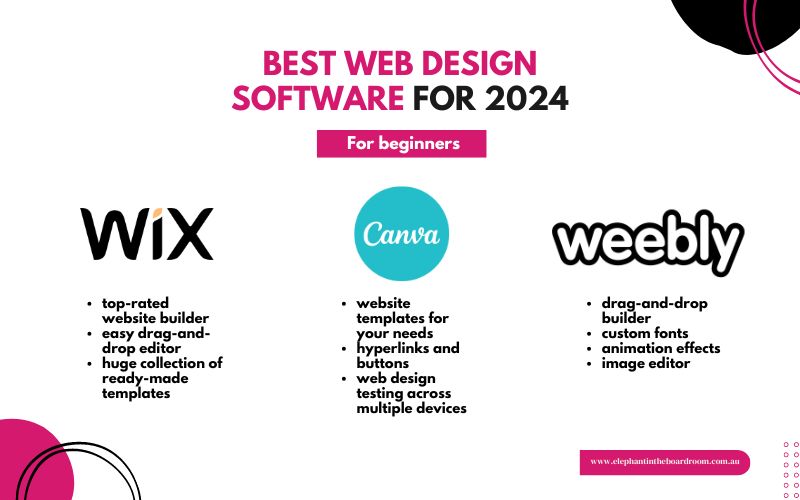
Venturing into the exciting world of website creation as a beginner? These options prioritise ease of use, drag-and-drop functionality, and pre-built elements to make your web design journey easier.
Wix
Wix remains one of the most popular web design tools for beginners with its user-friendly interface and customisable templates. The drag-and-drop editor makes building a website feel intuitive, and Wix offers plenty of tutorials and support resources to get you started.
Weebly
Another excellent choice for beginners, Weebly boasts a user-friendly interface and a strong focus on drag-and-drop functionality. It integrates well with other tools, so you can expand your website's capabilities as you learn and grow. Weebly also offers various pricing plans, allowing you to find one that suits your needs.
Canva
While not strictly a professional web designer, Canva's popularity with beginners makes it a worthy contender. Canva excels at creating high-quality graphics and social media content.
Beginner web designers can leverage Canva to design stunning website elements like banners, social media icons, and infographics. Canva's free plan offers a collection of budget-friendly design elements and templates.
Best Web Design Software for Professionals
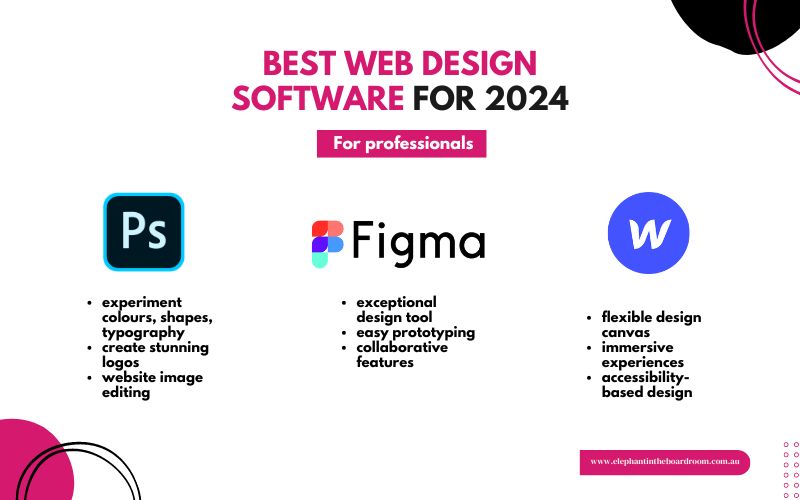
Suppose you're a professional web designer in 2024 and still searching for the best professional platform. In that case, these options balance strong design capabilities and powerful features for crafting modern websites.
Figma
This cloud-based software is a champion for collaboration and boasts exceptional design tools. Figma allows for easy prototyping, creating a seamless workflow from initial sketches to interactive prototypes. Its collaborative features make it perfect for teams working together on real-time projects.
Adobe Photoshop
While not strictly a web design editor, Photoshop's image editing prowess is undeniable. Professional web designers like you can rely on Photoshop to create high-quality graphics, icons, and other visual elements that elevate website aesthetics.
Webflow
Webflow's professional web design software bridges the gap between design and development. It lets designers create stunning and responsive websites visually, without needing to write tons of code. It offers a great deal of design freedom while still allowing for clean, exportable code.
Best Web Design Software for UI/UX Designers
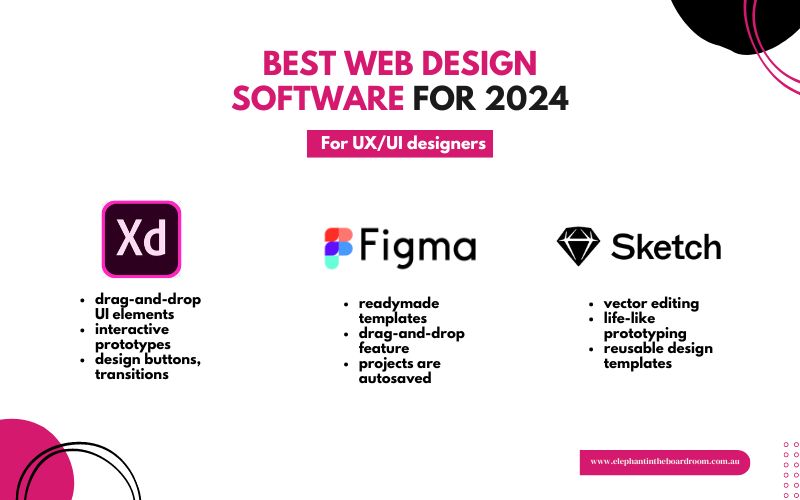
UI/UX designers can also enjoy these choices, where prototyping and team workflows can be supported. A website's ROI is guaranteed up to 100% when you implement great UI/UX techniques.
Figma
This cloud-based champion reigns supreme for many UI/UX designers. Figma offers a comprehensive suite of design tools, allowing for user interface creation, prototyping with interactive elements, and user flow mapping – all within the same platform. Its collaborative features like real-time editing make it a dream for design teams.
Sketch
This industry-standard software is popular among Mac users for UI design. Sketch boasts a clean interface and powerful vector editing tools, perfect for crafting pixel-perfect user interfaces. While it has prototyping limitations compared to Figma, some designers still prefer its design-centric approach.
Adobe XD
For those entrenched in the Adobe ecosystem, Adobe XD offers a strong contender specifically built for UI/UX design. It provides a smooth workflow from design to prototyping, allowing designers to create interactive prototypes and user flows. XD integrates well with other Adobe products, making it a good choice for teams already using the Adobe suite.
Best Web Design Software for eCommerce
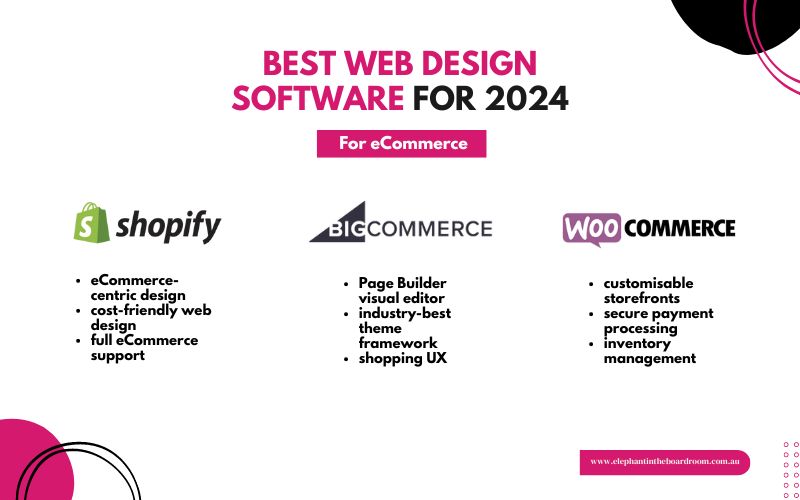
Are you an eCommerce business? You might need more from software than just pure design. About 60% of your consumers believe that if your website is useful, they will trust your brand.
Thankfully, these three eCommerce-friendly web design software cover your needs.
Shopify
This isn't just your typical web designer; it's a comprehensive eCommerce platform. Shopify offers a user-friendly interface with a focus on building online stores. It includes built-in features for product management, shopping carts, secure payment gateways, and even marketing tools.
While design flexibility might be limited compared to some options, Shopify excels in creating functional and successful online stores.
WooCommerce
This powerful plugin for WordPress allows you to transform your existing website into a full-fledged online store. WooCommerce offers customisation and design freedom, letting you use WordPress themes to create a unique look for your store.
The downside? WooCommerce requires some technical knowledge to set up and maintain, making it less beginner-friendly than Shopify.
BigCommerce
BigCommerce is a robust e-commerce platform that caters to businesses with high sales volume or complex product needs. It offers a scalable solution with advanced features like product variations, B2B functionality, and built-in SEO tools.
The design interface is user-friendly, with a good selection of themes, but again, it might not be as beginner-friendly as Shopify for those just starting.
Best Web Design Software for Non Coders
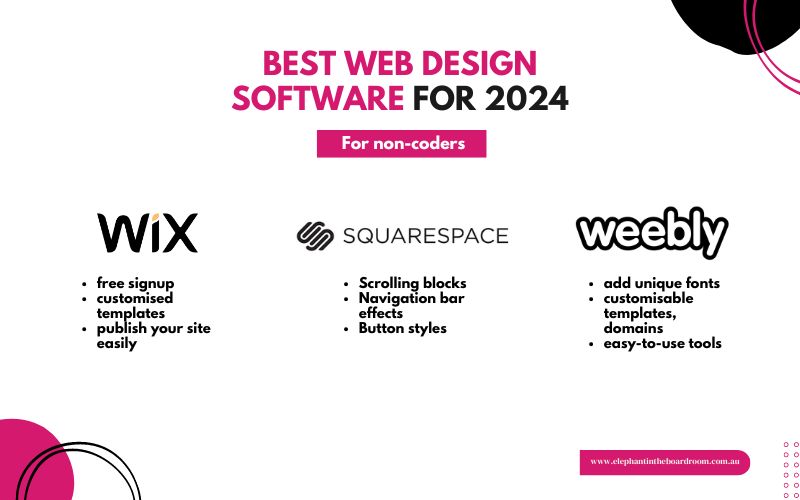
Want to design a website but hate the coding part? These top web design options have everything you need except the coding, from user-friendliness, drag-and-drop functionality, and pre-built elements.
Wix
Wix has appeared many times on our lists, and it remains a crowd favourite for non-coders with its exceptionally user-friendly interface and a collection of beautiful, customisable templates.
The drag-and-drop editor makes building a website feel intuitive, and Wix offers plenty of tutorials and support resources to get you started. It also has a free plan, so you can experiment before committing.
Weebly
Another excellent choice for non-coders, Weebly boasts a clean interface with a strong focus on drag-and-drop functionality. Similar to Wix, Weebly offers a collection of pre-built themes and elements, making it easy to design a website without needing coding knowledge.
Additionally, Weebly integrates well with other tools, allowing you to expand your website's capabilities as you learn and grow.
Squarespace
Renowned for its beautiful design templates, Squarespace is a great option for non-coders who prioritise aesthetics. This web design software offers a user-friendly interface with drag-and-drop functionality, allowing you to build a visually appealing website with minimal coding knowledge.
While it might have slightly less design flexibility compared to Wix or Weebly, Squarespace excels in creating polished and professional-looking websites.
Best Open Source Web Design Software
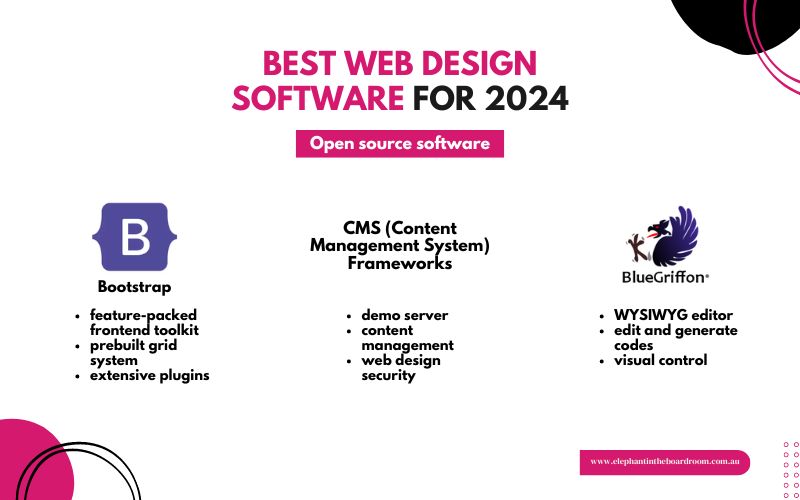
While these open-source online web design spaces offer flexibility and cost-effectiveness, they often require more technical knowledge than user-friendly website builders.
Bootstrap
This isn't exactly software, but a powerful open-source framework for front-end web development. Bootstrap offers a collection of pre-built components like buttons, forms, and navigation bars, along with a grid system for responsive design.
While it requires some HTML, CSS, and JavaScript knowledge to use effectively, Bootstrap can jumpstart your website development and ensure a mobile-friendly layout.
BlueGriffon
This WYSIWYG (What You See Is What You Get) editor bridges the gap between code and design. BlueGriffon allows you to visually edit your website layout while automatically generating the underlying code.
It's a good option for those who want visual control but also want to learn basic HTML and CSS. However, BlueGriffon has a steeper learning curve compared to drag-and-drop website builders.
CMS (Content Management System) Frameworks
For those comfortable with coding, open-source CMS frameworks like Drupal and Joomla! offer a powerful foundation for building complex websites. They provide a user interface for managing content (text, images, etc.) while giving you full control over the website's design and functionality through coding.
Drupal and Joomla! have large communities and extensive resources available, but they require significant development expertise to use effectively.
Web Design Made Better With Us!
So, what's the verdict, legends?
We hope we've helped you navigate the wild world of web design software! Remember, the best choice depends on your skills and what you want to achieve.
But hey, if you're still feeling lost in the digital outback, don't sweat it! Elephant in the Boardroom is here to answer your website design needs. Let's help you choose the perfect software, and design a website that gets it done, whatever your web design goals are.
Contact us today here for a free consultation, and let's build a website that truly shines among the rest!

A great web design software is like a magic wand, transforming ideas into visually stunning, user-friendly masterpieces with just a few clicks.
With 2024 bringing new advancements and trends, staying updated on the best web design software is essential to create beautiful and functional websites. But with a lot of web designing platforms available, how do you pick the right one?
Whether you're a web design pro, a beginner, a business owner, or just someone interested in web design - the struggle is real. That's why we're spilling the beans on the best software for web design for different types of creators.
Find your perfect match through our exhaustive recommendations of web design platforms, tailored for your design needs. Hope you find yours here.
What’s Inside?
- Best Web Design Software for Beginners
- Best Web Design Software for Professionals
- Best Web Design Software for UI/UX Designers
- Best Web Design Software for eCommerce
- Best Web Design Software for Non Coders
- Best Open Source Web Design Software
- Web Design Made Better With Us!
Best Web Design Software for Beginners

Venturing into the exciting world of website creation as a beginner? These options prioritise ease of use, drag-and-drop functionality, and pre-built elements to make your web design journey easier.
Wix
Wix remains one of the most popular web design tools for beginners with its user-friendly interface and customisable templates. The drag-and-drop editor makes building a website feel intuitive, and Wix offers plenty of tutorials and support resources to get you started.
Weebly
Another excellent choice for beginners, Weebly boasts a user-friendly interface and a strong focus on drag-and-drop functionality. It integrates well with other tools, so you can expand your website's capabilities as you learn and grow. Weebly also offers various pricing plans, allowing you to find one that suits your needs.
Canva
While not strictly a professional web designer, Canva's popularity with beginners makes it a worthy contender. Canva excels at creating high-quality graphics and social media content.
Beginner web designers can leverage Canva to design stunning website elements like banners, social media icons, and infographics. Canva's free plan offers a collection of budget-friendly design elements and templates.
Best Web Design Software for Professionals

Suppose you're a professional web designer in 2024 and still searching for the best professional platform. In that case, these options balance strong design capabilities and powerful features for crafting modern websites.
Figma
This cloud-based software is a champion for collaboration and boasts exceptional design tools. Figma allows for easy prototyping, creating a seamless workflow from initial sketches to interactive prototypes. Its collaborative features make it perfect for teams working together on real-time projects.
Adobe Photoshop
While not strictly a web design editor, Photoshop's image editing prowess is undeniable. Professional web designers like you can rely on Photoshop to create high-quality graphics, icons, and other visual elements that elevate website aesthetics.
Webflow
Webflow's professional web design software bridges the gap between design and development. It lets designers create stunning and responsive websites visually, without needing to write tons of code. It offers a great deal of design freedom while still allowing for clean, exportable code.
Best Web Design Software for UI/UX Designers

UI/UX designers can also enjoy these choices, where prototyping and team workflows can be supported. A website's ROI is guaranteed up to 100% when you implement great UI/UX techniques.
Figma
This cloud-based champion reigns supreme for many UI/UX designers. Figma offers a comprehensive suite of design tools, allowing for user interface creation, prototyping with interactive elements, and user flow mapping – all within the same platform. Its collaborative features like real-time editing make it a dream for design teams.
Sketch
This industry-standard software is popular among Mac users for UI design. Sketch boasts a clean interface and powerful vector editing tools, perfect for crafting pixel-perfect user interfaces. While it has prototyping limitations compared to Figma, some designers still prefer its design-centric approach.
Adobe XD
For those entrenched in the Adobe ecosystem, Adobe XD offers a strong contender specifically built for UI/UX design. It provides a smooth workflow from design to prototyping, allowing designers to create interactive prototypes and user flows. XD integrates well with other Adobe products, making it a good choice for teams already using the Adobe suite.
Best Web Design Software for eCommerce

Are you an eCommerce business? You might need more from software than just pure design. About 60% of your consumers believe that if your website is useful, they will trust your brand.
Thankfully, these three eCommerce-friendly web design software cover your needs.
Shopify
This isn't just your typical web designer; it's a comprehensive eCommerce platform. Shopify offers a user-friendly interface with a focus on building online stores. It includes built-in features for product management, shopping carts, secure payment gateways, and even marketing tools.
While design flexibility might be limited compared to some options, Shopify excels in creating functional and successful online stores.
WooCommerce
This powerful plugin for WordPress allows you to transform your existing website into a full-fledged online store. WooCommerce offers customisation and design freedom, letting you use WordPress themes to create a unique look for your store.
The downside? WooCommerce requires some technical knowledge to set up and maintain, making it less beginner-friendly than Shopify.
BigCommerce
BigCommerce is a robust e-commerce platform that caters to businesses with high sales volume or complex product needs. It offers a scalable solution with advanced features like product variations, B2B functionality, and built-in SEO tools.
The design interface is user-friendly, with a good selection of themes, but again, it might not be as beginner-friendly as Shopify for those just starting.
Best Web Design Software for Non Coders

Want to design a website but hate the coding part? These top web design options have everything you need except the coding, from user-friendliness, drag-and-drop functionality, and pre-built elements.
Wix
Wix has appeared many times on our lists, and it remains a crowd favourite for non-coders with its exceptionally user-friendly interface and a collection of beautiful, customisable templates.
The drag-and-drop editor makes building a website feel intuitive, and Wix offers plenty of tutorials and support resources to get you started. It also has a free plan, so you can experiment before committing.
Weebly
Another excellent choice for non-coders, Weebly boasts a clean interface with a strong focus on drag-and-drop functionality. Similar to Wix, Weebly offers a collection of pre-built themes and elements, making it easy to design a website without needing coding knowledge.
Additionally, Weebly integrates well with other tools, allowing you to expand your website's capabilities as you learn and grow.
Squarespace
Renowned for its beautiful design templates, Squarespace is a great option for non-coders who prioritise aesthetics. This web design software offers a user-friendly interface with drag-and-drop functionality, allowing you to build a visually appealing website with minimal coding knowledge.
While it might have slightly less design flexibility compared to Wix or Weebly, Squarespace excels in creating polished and professional-looking websites.
Best Open Source Web Design Software

While these open-source online web design spaces offer flexibility and cost-effectiveness, they often require more technical knowledge than user-friendly website builders.
Bootstrap
This isn't exactly software, but a powerful open-source framework for front-end web development. Bootstrap offers a collection of pre-built components like buttons, forms, and navigation bars, along with a grid system for responsive design.
While it requires some HTML, CSS, and JavaScript knowledge to use effectively, Bootstrap can jumpstart your website development and ensure a mobile-friendly layout.
BlueGriffon
This WYSIWYG (What You See Is What You Get) editor bridges the gap between code and design. BlueGriffon allows you to visually edit your website layout while automatically generating the underlying code.
It's a good option for those who want visual control but also want to learn basic HTML and CSS. However, BlueGriffon has a steeper learning curve compared to drag-and-drop website builders.
CMS (Content Management System) Frameworks
For those comfortable with coding, open-source CMS frameworks like Drupal and Joomla! offer a powerful foundation for building complex websites. They provide a user interface for managing content (text, images, etc.) while giving you full control over the website's design and functionality through coding.
Drupal and Joomla! have large communities and extensive resources available, but they require significant development expertise to use effectively.
Web Design Made Better With Us!
So, what's the verdict, legends?
We hope we've helped you navigate the wild world of web design software! Remember, the best choice depends on your skills and what you want to achieve.
But hey, if you're still feeling lost in the digital outback, don't sweat it! Elephant in the Boardroom is here to answer your website design needs. Let's help you choose the perfect software, and design a website that gets it done, whatever your web design goals are.
Contact us today here for a free consultation, and let's build a website that truly shines among the rest!

A great web design software is like a magic wand, transforming ideas into visually stunning, user-friendly masterpieces with just a few clicks.
With 2024 bringing new advancements and trends, staying updated on the best web design software is essential to create beautiful and functional websites. But with a lot of web designing platforms available, how do you pick the right one?
Whether you're a web design pro, a beginner, a business owner, or just someone interested in web design - the struggle is real. That's why we're spilling the beans on the best software for web design for different types of creators.
Find your perfect match through our exhaustive recommendations of web design platforms, tailored for your design needs. Hope you find yours here.
What’s Inside?
- Best Web Design Software for Beginners
- Best Web Design Software for Professionals
- Best Web Design Software for UI/UX Designers
- Best Web Design Software for eCommerce
- Best Web Design Software for Non Coders
- Best Open Source Web Design Software
- Web Design Made Better With Us!
Best Web Design Software for Beginners

Venturing into the exciting world of website creation as a beginner? These options prioritise ease of use, drag-and-drop functionality, and pre-built elements to make your web design journey easier.
Wix
Wix remains one of the most popular web design tools for beginners with its user-friendly interface and customisable templates. The drag-and-drop editor makes building a website feel intuitive, and Wix offers plenty of tutorials and support resources to get you started.
Weebly
Another excellent choice for beginners, Weebly boasts a user-friendly interface and a strong focus on drag-and-drop functionality. It integrates well with other tools, so you can expand your website's capabilities as you learn and grow. Weebly also offers various pricing plans, allowing you to find one that suits your needs.
Canva
While not strictly a professional web designer, Canva's popularity with beginners makes it a worthy contender. Canva excels at creating high-quality graphics and social media content.
Beginner web designers can leverage Canva to design stunning website elements like banners, social media icons, and infographics. Canva's free plan offers a collection of budget-friendly design elements and templates.
Best Web Design Software for Professionals

Suppose you're a professional web designer in 2024 and still searching for the best professional platform. In that case, these options balance strong design capabilities and powerful features for crafting modern websites.
Figma
This cloud-based software is a champion for collaboration and boasts exceptional design tools. Figma allows for easy prototyping, creating a seamless workflow from initial sketches to interactive prototypes. Its collaborative features make it perfect for teams working together on real-time projects.
Adobe Photoshop
While not strictly a web design editor, Photoshop's image editing prowess is undeniable. Professional web designers like you can rely on Photoshop to create high-quality graphics, icons, and other visual elements that elevate website aesthetics.
Webflow
Webflow's professional web design software bridges the gap between design and development. It lets designers create stunning and responsive websites visually, without needing to write tons of code. It offers a great deal of design freedom while still allowing for clean, exportable code.
Best Web Design Software for UI/UX Designers

UI/UX designers can also enjoy these choices, where prototyping and team workflows can be supported. A website's ROI is guaranteed up to 100% when you implement great UI/UX techniques.
Figma
This cloud-based champion reigns supreme for many UI/UX designers. Figma offers a comprehensive suite of design tools, allowing for user interface creation, prototyping with interactive elements, and user flow mapping – all within the same platform. Its collaborative features like real-time editing make it a dream for design teams.
Sketch
This industry-standard software is popular among Mac users for UI design. Sketch boasts a clean interface and powerful vector editing tools, perfect for crafting pixel-perfect user interfaces. While it has prototyping limitations compared to Figma, some designers still prefer its design-centric approach.
Adobe XD
For those entrenched in the Adobe ecosystem, Adobe XD offers a strong contender specifically built for UI/UX design. It provides a smooth workflow from design to prototyping, allowing designers to create interactive prototypes and user flows. XD integrates well with other Adobe products, making it a good choice for teams already using the Adobe suite.
Best Web Design Software for eCommerce

Are you an eCommerce business? You might need more from software than just pure design. About 60% of your consumers believe that if your website is useful, they will trust your brand.
Thankfully, these three eCommerce-friendly web design software cover your needs.
Shopify
This isn't just your typical web designer; it's a comprehensive eCommerce platform. Shopify offers a user-friendly interface with a focus on building online stores. It includes built-in features for product management, shopping carts, secure payment gateways, and even marketing tools.
While design flexibility might be limited compared to some options, Shopify excels in creating functional and successful online stores.
WooCommerce
This powerful plugin for WordPress allows you to transform your existing website into a full-fledged online store. WooCommerce offers customisation and design freedom, letting you use WordPress themes to create a unique look for your store.
The downside? WooCommerce requires some technical knowledge to set up and maintain, making it less beginner-friendly than Shopify.
BigCommerce
BigCommerce is a robust e-commerce platform that caters to businesses with high sales volume or complex product needs. It offers a scalable solution with advanced features like product variations, B2B functionality, and built-in SEO tools.
The design interface is user-friendly, with a good selection of themes, but again, it might not be as beginner-friendly as Shopify for those just starting.
Best Web Design Software for Non Coders

Want to design a website but hate the coding part? These top web design options have everything you need except the coding, from user-friendliness, drag-and-drop functionality, and pre-built elements.
Wix
Wix has appeared many times on our lists, and it remains a crowd favourite for non-coders with its exceptionally user-friendly interface and a collection of beautiful, customisable templates.
The drag-and-drop editor makes building a website feel intuitive, and Wix offers plenty of tutorials and support resources to get you started. It also has a free plan, so you can experiment before committing.
Weebly
Another excellent choice for non-coders, Weebly boasts a clean interface with a strong focus on drag-and-drop functionality. Similar to Wix, Weebly offers a collection of pre-built themes and elements, making it easy to design a website without needing coding knowledge.
Additionally, Weebly integrates well with other tools, allowing you to expand your website's capabilities as you learn and grow.
Squarespace
Renowned for its beautiful design templates, Squarespace is a great option for non-coders who prioritise aesthetics. This web design software offers a user-friendly interface with drag-and-drop functionality, allowing you to build a visually appealing website with minimal coding knowledge.
While it might have slightly less design flexibility compared to Wix or Weebly, Squarespace excels in creating polished and professional-looking websites.
Best Open Source Web Design Software

While these open-source online web design spaces offer flexibility and cost-effectiveness, they often require more technical knowledge than user-friendly website builders.
Bootstrap
This isn't exactly software, but a powerful open-source framework for front-end web development. Bootstrap offers a collection of pre-built components like buttons, forms, and navigation bars, along with a grid system for responsive design.
While it requires some HTML, CSS, and JavaScript knowledge to use effectively, Bootstrap can jumpstart your website development and ensure a mobile-friendly layout.
BlueGriffon
This WYSIWYG (What You See Is What You Get) editor bridges the gap between code and design. BlueGriffon allows you to visually edit your website layout while automatically generating the underlying code.
It's a good option for those who want visual control but also want to learn basic HTML and CSS. However, BlueGriffon has a steeper learning curve compared to drag-and-drop website builders.
CMS (Content Management System) Frameworks
For those comfortable with coding, open-source CMS frameworks like Drupal and Joomla! offer a powerful foundation for building complex websites. They provide a user interface for managing content (text, images, etc.) while giving you full control over the website's design and functionality through coding.
Drupal and Joomla! have large communities and extensive resources available, but they require significant development expertise to use effectively.
Web Design Made Better With Us!
So, what's the verdict, legends?
We hope we've helped you navigate the wild world of web design software! Remember, the best choice depends on your skills and what you want to achieve.
But hey, if you're still feeling lost in the digital outback, don't sweat it! Elephant in the Boardroom is here to answer your website design needs. Let's help you choose the perfect software, and design a website that gets it done, whatever your web design goals are.
Contact us today here for a free consultation, and let's build a website that truly shines among the rest!

A great web design software is like a magic wand, transforming ideas into visually stunning, user-friendly masterpieces with just a few clicks.
With 2024 bringing new advancements and trends, staying updated on the best web design software is essential to create beautiful and functional websites. But with a lot of web designing platforms available, how do you pick the right one?
Whether you're a web design pro, a beginner, a business owner, or just someone interested in web design - the struggle is real. That's why we're spilling the beans on the best software for web design for different types of creators.
Find your perfect match through our exhaustive recommendations of web design platforms, tailored for your design needs. Hope you find yours here.
What’s Inside?
- Best Web Design Software for Beginners
- Best Web Design Software for Professionals
- Best Web Design Software for UI/UX Designers
- Best Web Design Software for eCommerce
- Best Web Design Software for Non Coders
- Best Open Source Web Design Software
- Web Design Made Better With Us!
Best Web Design Software for Beginners

Venturing into the exciting world of website creation as a beginner? These options prioritise ease of use, drag-and-drop functionality, and pre-built elements to make your web design journey easier.
Wix
Wix remains one of the most popular web design tools for beginners with its user-friendly interface and customisable templates. The drag-and-drop editor makes building a website feel intuitive, and Wix offers plenty of tutorials and support resources to get you started.
Weebly
Another excellent choice for beginners, Weebly boasts a user-friendly interface and a strong focus on drag-and-drop functionality. It integrates well with other tools, so you can expand your website's capabilities as you learn and grow. Weebly also offers various pricing plans, allowing you to find one that suits your needs.
Canva
While not strictly a professional web designer, Canva's popularity with beginners makes it a worthy contender. Canva excels at creating high-quality graphics and social media content.
Beginner web designers can leverage Canva to design stunning website elements like banners, social media icons, and infographics. Canva's free plan offers a collection of budget-friendly design elements and templates.
Best Web Design Software for Professionals

Suppose you're a professional web designer in 2024 and still searching for the best professional platform. In that case, these options balance strong design capabilities and powerful features for crafting modern websites.
Figma
This cloud-based software is a champion for collaboration and boasts exceptional design tools. Figma allows for easy prototyping, creating a seamless workflow from initial sketches to interactive prototypes. Its collaborative features make it perfect for teams working together on real-time projects.
Adobe Photoshop
While not strictly a web design editor, Photoshop's image editing prowess is undeniable. Professional web designers like you can rely on Photoshop to create high-quality graphics, icons, and other visual elements that elevate website aesthetics.
Webflow
Webflow's professional web design software bridges the gap between design and development. It lets designers create stunning and responsive websites visually, without needing to write tons of code. It offers a great deal of design freedom while still allowing for clean, exportable code.
Best Web Design Software for UI/UX Designers

UI/UX designers can also enjoy these choices, where prototyping and team workflows can be supported. A website's ROI is guaranteed up to 100% when you implement great UI/UX techniques.
Figma
This cloud-based champion reigns supreme for many UI/UX designers. Figma offers a comprehensive suite of design tools, allowing for user interface creation, prototyping with interactive elements, and user flow mapping – all within the same platform. Its collaborative features like real-time editing make it a dream for design teams.
Sketch
This industry-standard software is popular among Mac users for UI design. Sketch boasts a clean interface and powerful vector editing tools, perfect for crafting pixel-perfect user interfaces. While it has prototyping limitations compared to Figma, some designers still prefer its design-centric approach.
Adobe XD
For those entrenched in the Adobe ecosystem, Adobe XD offers a strong contender specifically built for UI/UX design. It provides a smooth workflow from design to prototyping, allowing designers to create interactive prototypes and user flows. XD integrates well with other Adobe products, making it a good choice for teams already using the Adobe suite.
Best Web Design Software for eCommerce

Are you an eCommerce business? You might need more from software than just pure design. About 60% of your consumers believe that if your website is useful, they will trust your brand.
Thankfully, these three eCommerce-friendly web design software cover your needs.
Shopify
This isn't just your typical web designer; it's a comprehensive eCommerce platform. Shopify offers a user-friendly interface with a focus on building online stores. It includes built-in features for product management, shopping carts, secure payment gateways, and even marketing tools.
While design flexibility might be limited compared to some options, Shopify excels in creating functional and successful online stores.
WooCommerce
This powerful plugin for WordPress allows you to transform your existing website into a full-fledged online store. WooCommerce offers customisation and design freedom, letting you use WordPress themes to create a unique look for your store.
The downside? WooCommerce requires some technical knowledge to set up and maintain, making it less beginner-friendly than Shopify.
BigCommerce
BigCommerce is a robust e-commerce platform that caters to businesses with high sales volume or complex product needs. It offers a scalable solution with advanced features like product variations, B2B functionality, and built-in SEO tools.
The design interface is user-friendly, with a good selection of themes, but again, it might not be as beginner-friendly as Shopify for those just starting.
Best Web Design Software for Non Coders

Want to design a website but hate the coding part? These top web design options have everything you need except the coding, from user-friendliness, drag-and-drop functionality, and pre-built elements.
Wix
Wix has appeared many times on our lists, and it remains a crowd favourite for non-coders with its exceptionally user-friendly interface and a collection of beautiful, customisable templates.
The drag-and-drop editor makes building a website feel intuitive, and Wix offers plenty of tutorials and support resources to get you started. It also has a free plan, so you can experiment before committing.
Weebly
Another excellent choice for non-coders, Weebly boasts a clean interface with a strong focus on drag-and-drop functionality. Similar to Wix, Weebly offers a collection of pre-built themes and elements, making it easy to design a website without needing coding knowledge.
Additionally, Weebly integrates well with other tools, allowing you to expand your website's capabilities as you learn and grow.
Squarespace
Renowned for its beautiful design templates, Squarespace is a great option for non-coders who prioritise aesthetics. This web design software offers a user-friendly interface with drag-and-drop functionality, allowing you to build a visually appealing website with minimal coding knowledge.
While it might have slightly less design flexibility compared to Wix or Weebly, Squarespace excels in creating polished and professional-looking websites.
Best Open Source Web Design Software

While these open-source online web design spaces offer flexibility and cost-effectiveness, they often require more technical knowledge than user-friendly website builders.
Bootstrap
This isn't exactly software, but a powerful open-source framework for front-end web development. Bootstrap offers a collection of pre-built components like buttons, forms, and navigation bars, along with a grid system for responsive design.
While it requires some HTML, CSS, and JavaScript knowledge to use effectively, Bootstrap can jumpstart your website development and ensure a mobile-friendly layout.
BlueGriffon
This WYSIWYG (What You See Is What You Get) editor bridges the gap between code and design. BlueGriffon allows you to visually edit your website layout while automatically generating the underlying code.
It's a good option for those who want visual control but also want to learn basic HTML and CSS. However, BlueGriffon has a steeper learning curve compared to drag-and-drop website builders.
CMS (Content Management System) Frameworks
For those comfortable with coding, open-source CMS frameworks like Drupal and Joomla! offer a powerful foundation for building complex websites. They provide a user interface for managing content (text, images, etc.) while giving you full control over the website's design and functionality through coding.
Drupal and Joomla! have large communities and extensive resources available, but they require significant development expertise to use effectively.
Web Design Made Better With Us!
So, what's the verdict, legends?
We hope we've helped you navigate the wild world of web design software! Remember, the best choice depends on your skills and what you want to achieve.
But hey, if you're still feeling lost in the digital outback, don't sweat it! Elephant in the Boardroom is here to answer your website design needs. Let's help you choose the perfect software, and design a website that gets it done, whatever your web design goals are.
Contact us today here for a free consultation, and let's build a website that truly shines among the rest!
Pagination
- Previous page
- Page 34
- Next page


